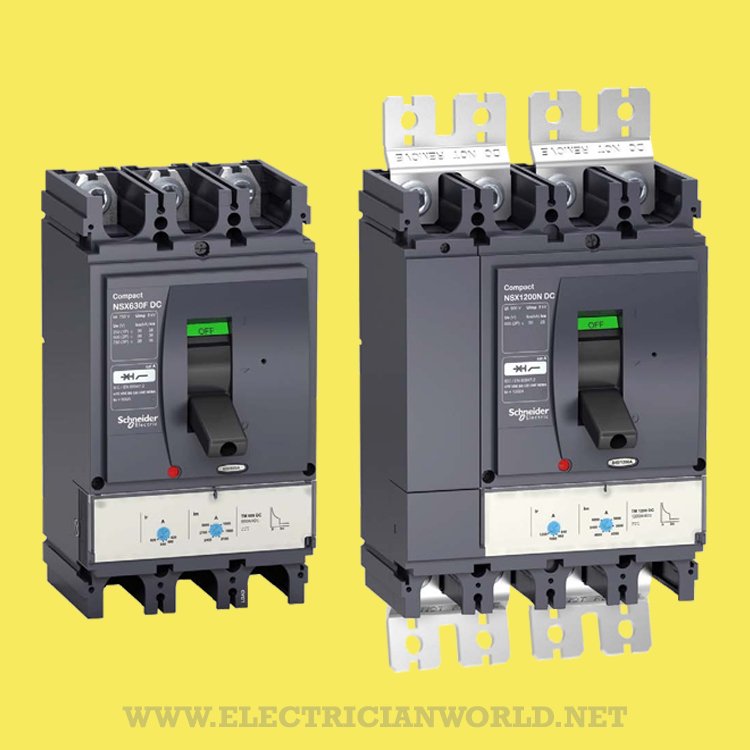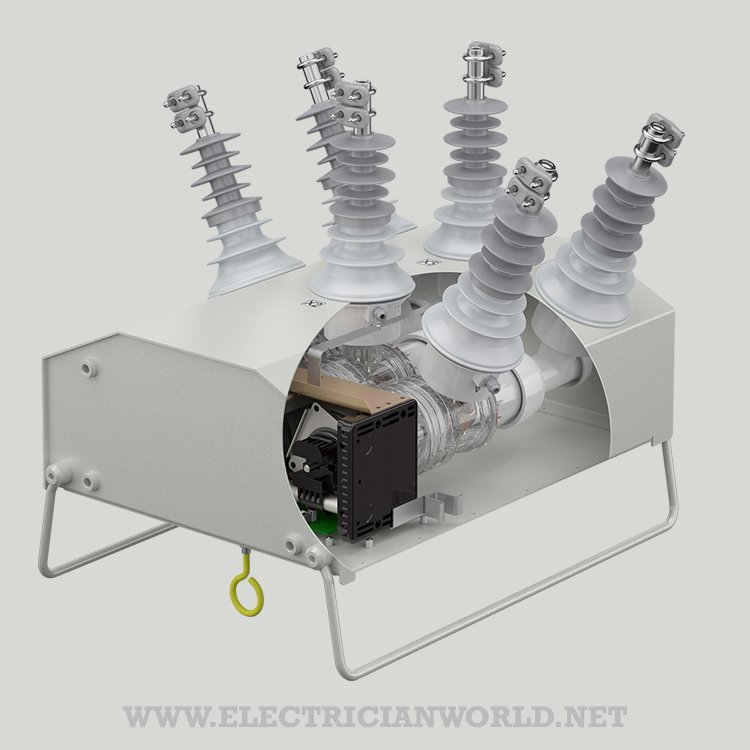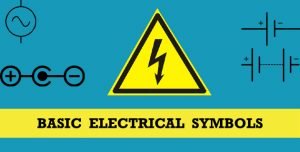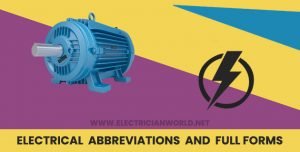Basic Electrical Definitions | What are electrical definitions? what is the use of studying the electrical terms definition? Now you have these questions right. Basic electrical definitions are used to define the electrical related object or thing or equipment.
We are going to study about ohm’s law, electric circuit, electric power, electrical current, electrical resistance, electrical voltage, ampere definition in this post. Basic electrical definitions are mandatory for the electrical engineers. To know 101 Basic Electrical Definitions read this article completely.
Table of Contents
A & B – Basic Electrical Definitions
In this table we are going to see the electrical definitions of accessory, appliance, arm’s reach, accessible, readily accessible, ampere and box.
Accessory: a device, other than electrical current-using equipment, associated with an Electrical Installation.
Appliance: an item of electrical current-using equipment.
Arm’s Reach: a zone of accessibility to touch, extending from any point on a surface where a person may stand or move about, to the limits which such person may reach without assistance (i.e. without any tool or ladder, etc.). Such a distance may be taken as 2.5 m height from the standing surface, and 1.25 m horizontally from the standing position.
Accessible: Three common uses of accessible: (wiring methods) – Capable of being removed or exposed without damaging the building structure of finish, or not permanently enclosed by such. Wires in concealed raceways are not considered accessible. (equipment) – Admitting close approach; not guarded by locked doors or other effective means.
(a) Readily Accessible – Capable of being reached quickly for operation, renewal, or inspections without the requirement of climbing over or removing obstacles or use of portable ladders, chairs, etc.
Ampere Definition: The unit of intensity of electrical current (the measure of electrical flow), is abbreviated a or A. The definition of ampere is only mention the unit of electrical current. The measurement of current is Ampere.
Box: An enclosure designed to provide access to the electrical wiring system. Uses include but are not limited to provide device and lighting outlets and wiring system junction points. Specially designed boxes are required for the support of listed ceiling fans weighing less than 35 lb.(15. kg). Fans exceeding this weight limit must be supported independently of the outlet box.

C & D – Basic Electrical Definitions
In this table we are going to see the electrical definitions of cable tray, cable trunking, category1 circuit, category 2 Circuit, category 3 circuit, circuit breaker, conductor, covered, insulated, device, distribution board, main distribution board (MDB), sub main distribution board (SMDB) and final distribution board (FDB). To know more electrical abbreviations and full forms for electrical interview click here.
Cable Tray: A cable support consisting of a continuous base with raised edges and no covering. A cable tray is considered to be perforated where more than 30% of the material is removed from the base.
Cable Trunking: A manufactured enclosure for the protection of cables, normally of rectangular cross-section, of which one side is removable or hinged.
Category 1 Circuit: A Circuit (other than a fire alarm or emergency lighting Circuit) operating at LV.
Category 2 Circuit: A Circuit (other than a fire alarm or emergency lighting Circuit) which supplies telecommunications equipment (such as telephones, intruder alarms, data transmission, call bells, etc.).
Category 3 Circuit: A fire alarm or emergency lighting Circuit.
Circuit Breaker: A device designed to open and close a circuit by non-automatic means and to open the circuit automatically on a predetermined over current without damaging itself when operated according to its rating.

Conductor: A substance or body capable of transmitting electricity. Bare – A conductor having no covering or electrical insulation whatsoever.
(a) Covered – A conductor encased within material of composition or thickness that is not recognized by the NEC as electrical insulation.
(b) Insulated – A conductor encased within material of composition or thickness that is recognized by the NEC as electrical insulation.
Device: A unit of an electrical system that is intended to carry but not utilize electricity.
Distribution Board: An assembly designed for housing isolation switches and Protective Devices and for connecting multiple Circuits, including their associated neutral and Earth Conductors. The following are related definitions:
(a) Main Distribution Board (MDB): The Distribution Board which accepts the main incoming LV supply from the Distribution Company or Owner’s transformer
(b) Sub Main Distribution Board (SMDB): Any Distribution Board which is neither a Main Distribution Board nor a Final Distribution Board (c) Final Distribution Board (FDB): A Distribution Board which supplies Final Circuits only.
E – Basic Electrical Definitions
In this table we are going to see the electrical definitions of earth, locally earthed system, distribution company earthed system, earth conductor, main earth conductor (MEC), circuit earth conductor (CEC), earth leakage protection (ELP), earth leakage protected system (ELPS), electric circuit definition, electric – ring circuit, electric – radial circuit, electric – final circuit, electric – distribution circuit, electrical current definition, direct current (D.C), alternating current(A.C), electrical installation definition, electrical voltage definition, high voltage (HV), low voltage (LV), extra-low voltage (ELV), separated extra-low voltage (SELV), protective extra-low voltage (PELV), reduced low voltage (RLV), electric power, electrical resistance, equipment, class I equipment, class II equipment and class III equipment.
Earth: The conductive mass of Earth, whose electrical potential (Electrical Voltage) at any point is conventionally taken as zero. The following are related definitions:
(a) Locally Earthed System : A system of supply where the Owner provides a Main Earth Terminal for the Electrical Installation, which is connected to a sufficient number of local Earth Electrodes to provide a maximum Earth Resistance measured at the Owner’s Main Earth Terminal of not more than 10 Ohms.
(b) Distribution Company Earthed System : A system of supply where the Distribution Company provides a connection to the Owner’s Main Earth Terminal, using the distribution network Earthing system.
Earth Conductor: A conductor used to connect Exposed Conductive-Parts of an Electrical Installation and associated Appliances to Earth, and providing a means for the safe passage of earth fault electrical current. This includes the following defined terms:
(a) Main Earth Conductor (MEC): Conductors connected between Earth Electrodes and Main Earth Terminals
(b) Circuit Earth Conductor (CEC): Conductors connecting all Circuits emanating from Main Distribution Boards, Sub Main Distribution Boards, Final Distribution Boards including Circuits connecting to equipment and Appliances. Outside these Regulations these may also be known as the Circuit Protective Conductor (CPC) or Earth Continuity Conductor (ECC).
Earth Leakage Protection (ELP): the provision of protection against electric shock due to Indirect Contact by the use of RCDs or other sensitive earth leakage Protective Devices which automatically disconnect the supply sufficiently quickly so as to prevent Danger to persons.
Earth Leakage Protection System (ELPS): a system of supply where Earth Leakage Protection is provided on Final Circuits and an additional ELPS is provided at the Electricity Intake.
Electric Circuit Definition: A set of phase and neutral conductors installed as a group to supply electric power to a location and which originate from one Protective Device. The following are Electric Circuit Definitions:
(a) Electric – Ring Circuit: A Electrical Circuit which is wired from a single Protective Device, being run through an area to be supplied (via appropriate socket-outlets, switched flex outlets, etc.) and returning back to the same Protective Device, thus forming an electrically continuous loop.
(b) Electric – Radial Circuit: A Electric Circuit which is wired in a ‘radial’ or ‘branch’ configuration, Emanating from a Protective Device, to the area to be supplied.
(c) Electric – Final Circuit: A Electric Circuit which directly supplies Appliances (normally via socket-outlets, switched flex outlets, isolators, ceiling roses, etc.)
(d) Electric – Distribution Circuit: A Electric Circuit connecting between Distribution Boards
Electrical Current Definition – A movement of electricity analogous to the flow of a stream of water. Electrical Current is also defined as flow of electrons.
(a) Direct Current (D.C) – An electrical current flowing in one direction only (i.e. current produced using a battery).
(b) Alternating Current(A.C) – A periodic electrical current that reverses its direction at regular intervals.
Electrical Installation Definition: an electrical installation comprises any fixed or temporary cable, switchgear or other electrical equipment or apparatus within a Premises or other place where there is an electricity supply (including outdoor locations). Fixed or portable electrical Appliances are not considered part of the Electrical Installation, although these Regulations do include requirements for the connection of Appliances (e.g. plugs and socket-outlets).
Electrical Voltage Definition : The unit of electromotive force (emf), the measure of electrical pressure, is abbreviated v or V, and Electrical Voltage is represented by V. The Electrical Voltage (of a circuit) is the effective (greatest root-mean-square) difference of potential between any two conductors of the circuit concerned.
Some systems, such as 3-phase 4-wire and single-phase 3-wire may have multiple circuits of differing voltages. The Nominal Electrical Voltage is the value assigned to a circuit to conveniently designate its voltage class (e.g. 120 volts, 240 volts, 480 volts). The actual electrical voltage of the circuit can vary.
(a) High Voltage (HV): An A.C. Voltage greater than Low Voltage and less than 36 kV between phases or 21 kV between any phase and Earth (internationally referred to as Medium Voltage)
(b) Low Voltage (LV): An A.C. Voltage below 1000 V between phases, or below 600 V between any phase and earth or a D.C Voltage below 1500 V between conductors, or below 900 V between any conductor and earth
(c) Extra-Low Voltage (ELV): An Voltage not exceeding 50 VAC or 120 VDC whether between live conductors or between live conductors and earth
(d) Separated Extra-Low Voltage (SELV): An Extra- Low Voltage system which is electrically Separated from Earth in such a way that a single fault cannot give rise to the risk of electric shock
(e) Protective Extra-Low Voltage (PELV): A system which has the same features as SELV except that connection of Exposed-Conductive-Parts to Earth Is allowed
(f) Reduced Low Voltage (RLV): A electrical voltage which does not exceed 55 VAC between phase and Earth or 110 VAC between phases.
Electric Power: Electric power is the rate, per unit time, at which electrical energy is transferred by an electric circuit. The SI unit of electric power is the watt, one joule per second. Electrical power measurement is in wattage.
Electrical Resistance: The electrical resistance definition is a measure of its opposition to the flow of electric current. Electrical Resistance is inverse quantity to the electrical conductance. SI unit of electrical resistance is R. Electrical resistance measured by ohms.
Equipment: A general term including material, fittings, devices, alliances, fixtures, apparatus, and similar items used as a part of, or in connection with, an electrical installation.
(a) Class I Equipment: equipment which includes a means for connection of Exposed-Conductive Parts of the equipment to the Earth Conductor, thus providing protection against electric shock in case of failure of the basic insulation of the equipment or other fault condition.
(b) Class II Equipment: equipment which does not include a means for connection to an Earth Conductor, and which provides supplementary insulation in addition to the basic insulation of the equipment such that a breakdown of the basic insulation will not present a dangerous electrical voltage on Exposed-Conductive-Parts.
(c) Class III Equipment: equipment in which protection against electric shock relies on supply at SELV and in which Voltages higher than SELV are not generated in the equipment.
F,G,K,L & N – Basic Electrical Definitions
In this table we are going to see the electrical definitions of fuse, GFCI(ground fault circuit interrupter), ground, kilowatt-hour, labeled, lamp, listed and NEC(National Electrical Code).
Fuse: An over electrical current protective device with a circuit opening part that is heated and broken by the passage of an over electrical current through it.
GFCI (Ground Fault Circuit Interrupter): A device intended for the protection of personnel that de-energizes a circuit or portion of a circuit when the electrical current to ground exceeds a preset value. ‘Ground Fault’ is the name applied to this undesired circuit condition. In dwelling units (e.g. houses, apartments), GFCI protection is currently required in bathrooms, garages, outdoors, unfinished basements, kitchens and wet bar sinks. Other specific installations and/or areas may also necessitate the need for protection.
Ground: A conducting connection, intentional or accidental, between an electrical circuit or equipment and the earth, or some conducting body that serves in place of the earth. Other associated terms are: Grounded conductor – A system or circuit conductor that is intentionally connected to ground. This conductor has also been referred to as the neutral or common conductor. Grounding conductor – a conductor used to connect equipment or the grounded circuit of a wiring system to the grounding electrode(s). Ungrounded conductor – a electrical current carrying conductor not connected to ground.
Kilowatt-hour: Work done at the steady rate equivalent to 1000 watts in one hour. Electric Power utility companies’ base their billing upon the number of kilowatt-hours (KWH) consumed.
Labeled: Equipment or materials that a label or other identifying mark of a listing organization has been attached.
Lamp: A general term for various devices for artificially producing light.
Listed: Equipment and/or materials included in a list published by an organization concerned with product evaluation and production of listed items. The listing states whether the item meets designated standards or is suitable for use in a specified manner. Listing organizations acceptable to jurisdiction authorities include Underwriters’ Laboratories (UL) and CSA.
NEC (National Electrical Code): A document produced by the National Fire Protection Association for the purpose of the practical safeguarding of persons and property from hazards arising from the use of electricity. Authorities having legal jurisdiction over electrical installations adopt the code for mandatory application.
O,P & S – Basic Electrical Definitions
In this table we are going to see the electrical definitions of ohm, ohm’s law, overcurrent, overload, phase, protective device, raceway, residual current device (RCD), receptacle, service and single-phase.
Ohm: The unit of electrical resistance and impedance, abbreviated with the electrical symbol omega, W. Electrical resistance is the opposition offered by a substance to the passage of electrical current. Impedance is the apparent resistance in a circuit to the flow of alternating current (A.C).
Ohm’s Law: A statement of the relationship, discovered by the German scientist G. S. Ohm, between the electrical voltage, current and electrical resistance of a circuit. It states the electrical voltage of a circuit in volts is equal to the product of the current in amperes and the electrical resistance in ohms.
Ohm’s Law V=IR, Electrical Current is directly proportional to the electrical voltage and inversely proportional to the electrical resistance.
Overcurrent: Any electrical current in excess of the rated current or ampacity. It may result from overload, short circuit or ground fault.
Overload: Operation in excess of normal full-load rating or rated ampacity which could cause damage or dangerous overheating if continued for a sufficient time. A fault, such as a short circuit or ground fault, is not an overload.
Phase: the point or stage in the period to which the rotation, oscillation, or variation has advanced relative to a standard position or starting point. electrically, one of the electrical voltage sources of an alternating current (A.C) electrical system whose voltage state is measured relative to a standard point.
Protective Device: a device installed at the start of a Circuit which will automatically disconnect the input of electricity in the event of a fault or overload occurring on that Circuit. Such devices include, but are not limited to, fuses, fuse links, Miniature Circuit Breakers (MCB), Moulded Case Circuit Breakers (MCCB) and Residual Current Devices (RCD).
Raceway: An enclosed channel of metallic or nonmetallic materials designed expressly for holding electrical wires, electrical cables, or busbars. Examples are electrical metallic tubing (EMT), flexible
Residual Current Device (RCD): a Protective Device which is installed to automatically isolate the supply to a Circuit or Distribution Board when the vector sum of electrical currents in the phase and neutral conductors reaches a preset value.
Receptacle: a device installed for the connection of a single contact device. Receptacles provide a means of connecting apparatus that utilize electricity to the wiring system.
Service: the conductors and equipment for delivering electrical energy from the supply system (e.g. the electric power utility) to the wiring system of the premises served.
Single Phase: A system of alternating current (A.C) electric power where the phase relationship Between ungrounded conductors is either 0 or 10 degrees.
T & W – Basic Electrical Definitions
In this table we are going to see the electrical definitions of three phase, transformer and watt (definition of watt).
Three Phase: A system of alternating current (A.C) electric power where the phase relationship between ungrounded conductors is either 0 or 120 degrees
Transformer: An apparatus for converting an alternating electrical current from a high to a low potential (electrical voltage) or vice versa. Uses of transformers include but are not limited to the conversion of utility transmission voltage to the voltage of the premises wiring system and conversion of voltage for use with chimes, alarm systems and low-voltage lighting. Transformers can also be used to compensate for minor variations equipment voltage requirements. Transformers only change electrical voltage and current.

Watt (Definition of watt) : The unit of electric power or rate of work represented by a electrical current of one ampere under a pressure of one volt (abbreviated w or W). The horsepower is approximately equal to 746 watts. Wattage ratings of lamps actually measure the electric power consumption not the illuminating capability. Watt is always calculated by one hour of the power consumption in electrical.
In this article we seen 101 basic electrical definitions of accessory, appliance, arm’s reach, accessible, readily accessible, ampere, box, cable tray, cable trunking, category 1 circuit, category 2 Circuit, category 3 circuit, circuit breaker, conductor, covered, insulated, device, distribution board, main distribution board (MDB), sub main distribution board (SMDB), final distribution board (FDB),earth, locally earthed system, distribution company earthed system, earth conductor, main earth conductor (MEC), circuit earth conductor (CEC), earth leakage protection (ELP), earth leakage protection system (ELPS), electric circuit definition, electric – ring circuit, electric – radial circuit, electric – final circuit, electric – distribution circuit, electrical current definition, direct current (D.C), alternating current(A.C), electrical installation definition, electrical voltage definition, high voltage (HV), low voltage (LV), extra-low voltage (ELV), separated extra-low voltage (SELV), protective extra-low voltage (PELV), reduced low voltage (RLV), electric power, electrical resistance, equipment, class I equipment, class II equipment, class III equipment, fuse, GFCI (Ground Fault Circuit Interrupter), ground, kilowatt-hour, labeled, lamp, listed, NEC(National Electrical Code), ohm, ohm’s law, overcurrent, overload, phase, protective device, raceway, residual current device (RCD), receptacle, service, single-phase, three phase, transformer and watt (definition of watt).
Final Word
Hope you understand this article about the Basic Electrical Definitions. Incase of any doubt please comment below. Please follow our website for future updates. Thank you for visiting our website – ElectricianWorld.Net




Sir, Can you please update the 300 electrical full forms in pdf file. It will be very useful in my interview time… Whenever i did attend the interview HR quistioned me what is full form of mcb, dp, ups, mccb,robo like that.. If you can update it as quick as possible.
What is current, volt, power, circuit? I want the clear explanation with detailness. You only mentioned those electrical definitions..
Electrical definitions – 101 great article..
All basic electrical definitions are in one place.. Thank you sir!
Thanks for your reply selvin. Subscribe our E2Z. Then you can get unlimited electrical article through mail.
We are on the updation process so will upload it soon sir.
This is for basic definition article latheef. If you want to know about more check our basic electrical categorizes..
Cover all basic. Thanks